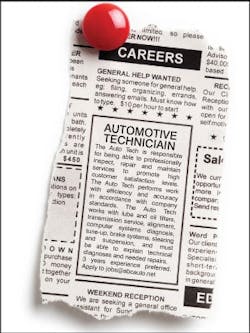First, the good news: According to U.S. Department of Labor statistics, consumer demand for mechanical repairers is on a steady rise, generating predictions of 17 percent growth in technician jobs between 2010 and 2020.
The bad news? Many in the industry are concerned that there won’t be enough new blood entering the mechanical repair workforce to fill those needs.
“It’s a concern, definitely,” says David Kusa, a shop owner and co-chairperson of the education committee of the Mechanical Division for the Automotive Service Association (ASA).
It seems to be simple math, Kusa says, as surveys have shown the average age of technicians to be mid-40s, and steadily increasing. (A recent study of 5,000 repairers conducted by Carlisle & Co. found the average age of dealership technicians at General Motors, Chrysler and Ford to be in their low-40s.)
With the combination of techs getting older and an influx of new jobs created, there could be gaping holes to fill.
“With the large numbers of Baby Boomers reaching retirement—8,000 a day across all industries for the next ten years or so—and the amount of them in the present technician demographic, there is some question as to whether our career and technical education system will be able to provide the properly trained and qualified entry-level employees in the numbers we’ll need,” says Tony Molla, vice president of communication for the National Institute for Automotive Service Excellence (ASE).
So, the problem becomes: How can the industry attract new talent, and what can shop owners do to ensure they can get the people they need?
Getting the ‘Best and Brightest’
The industry is very different today than when many mechanics joined the field some 20 years ago, Molla says. The increased technology in vehicle control systems and the rise of alternative powertrain technologies are only going to increase the need for higher-end technical and diagnostic skills for those working on vehicles, he says.
This means solid education platforms are a must.
“We need a better structure for providing a clear career path for those entering our CTE [career and technical education] system, or who are interested in pursuing a career in the automotive industry,” Molla says.
“We also need to do a better job of communicating the value and diversity of an automotive career to those with the proper technical skills. This is an area that the industry is only now beginning to address in earnest.”
The ASE Industry Education Alliance is working to fix that first part, Molla says, but recruiting people into such programs will still be crucial.
“We’re still fighting perception,” says Kusa. “There is still that opinion in the general public about that ‘grease monkey attitude.’ You didn’t do well in school, so you get shoved into a trade, either as an auto mechanic or some other trade. I think that still persists.”
The key is reaching out and trying to educate the general public, both Molla and Kusa say. Working with local colleges or high schools, even attending their career days as a representative of the industry, would go a long way, they say.
“It’s not all about taking things apart and putting them back together anymore,” Kusa says. “It’s about having a good technical background, being intelligent and having a good, logical head on your shoulders so that you can get from Point A to Point B with very difficult, technical problems.”
Get the Best at Your Shop
As with recruiting any new employee, Kusa says, shops need to have a workplace that is attractive to potential techs.
Kusa says a focus on competitive pay, proper equipment and a safe, clean and comfortable workplace make an enormous difference. Offering benefits and training opportunities also helps with recruiting, he says.
Molla suggests being more involved in local trade schools, serving on their advisory councils, developing internship or mentorship programs, or even becoming an instructor. That connection can create a pathway for students to come to your business.
“The need is only going to grow,” Kusa says of finding good technicians. “It’s going to get harder and harder to get them at your shop.”
About the Author

Bryce Evans
Bryce Evans is the vice president of content at 10 Missions Media, overseeing an award-winning team that produces FenderBender, Ratchet+Wrench and NOLN.
